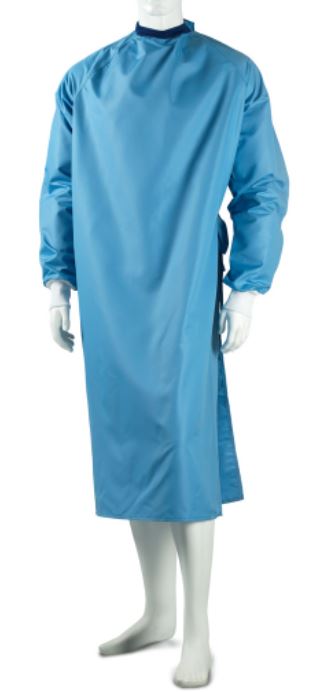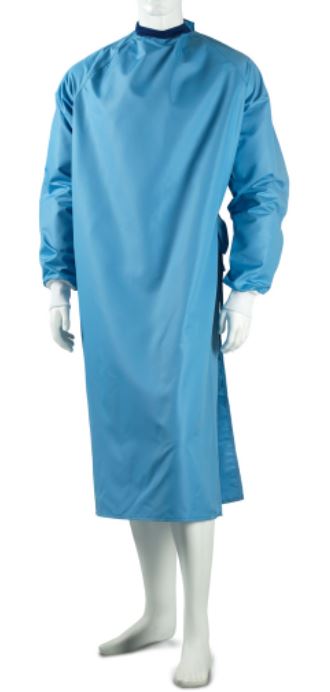SURGICAL GOWN, microfiber, standard perf., reusable, L
Valid Article
SURGICAL GOWN, reusable, microfiber
Definition
Reusable garment made of synthetic materials intended to be worn over a scrub suit to cover the arms, trunk, and upper legs, during a surgical procedure; it may be fluid resistant or impervious to fluids. Also known as an operating room (OR) gown, it is used during surgical procedures to help protect both the patient and operating room personnel from the transfer of microorganisms, body fluids, and particulate material.
This is a reusable garment intended to be laundered after each use.
Synonym
surgical smock
Specifications
Microfiber is defined as a staple fiber or filaments of linear density approximately 1 dtex or less, and above 0.3 dtex (Decitex = measuring unit for yarn; 1 gram per 10000 meters). Polyester and polyamide are the main source to produce microfibers.
Fabrics made of microfibers are generally lightweight, resist wrinkling, have a luxurious drape on the body, retain shape, and resist pilling. They are also relatively strong and durable in relation to other fabrics of similar weight, and they are more breathable and more comfortable to wear. Fabrics made of microfibers show lower heat conductance and therefore higher thermal insulation properties.
Quality standards
Technical specifications
- Fabric: microfiber carbon fabric, antistatic, water-resistant, high breathability. Latex-free. Withstands boiling and sterilization by steam autoclave; resists to chlorine 0.1%
- Barrier capacity of the whole gown: (liquid and bacterial penetration): standard performance
- For medium fluid level interventions
- Wraparound
- Long sleeves
- Cuffs made of elastic jersey
- The linen has a washing-counting label (80 washes)
- Length (shoulder seam to mid calf): collar in different colors to identify the size of the gown (Pluritex)
- size Large: ± 140 cm
- size XLarge: ± 150 cm
- size XXLarge: ± 160 cm
Instructions for use
Precautions for Use
According to the quality standards, the back of the surgical gown may have a low liquid penetration barrier performance: can be ANSI/AAMI-Level 1 even though the whole gown is classified as ANSI/AAMI-Level 4 surgical gown. Therefore, using a surgical gown in isolation settings may not provide appropriate protection.
Maintenance
Adapt procedure according the context and the temperature limits of the manufacturer.
All gowns must be laundered prior to use.
Barrier fabrics should be laundered separate from other hospital linens to minimize lint accumulation from other products and maximize the economics of the lightweight polyester fabric.
Recommended washing formula: Combination washer/extractors should be loaded at approximately 70-75% capacity to allow correct flow of water across surfaces of these fabrics.
- Do not use softener.
- Do not use a brush: as the fabric is water repellent liquids will not penetrate. The use of a brush will deteriorate the fabric faster!
During the washing process a chemical or thermal disinfection is necessary - chemical disinfection can be done by active oxygen releasing chemicals (e.g. peracetic acid) or 0,1% chlorine solution (keep in mind that chlorine could reduce the maximum lifetime of the surgical gowns and drapes)
Take care to have a sufficient rinsing to avoid damaging of the surgical gowns during the following drying and sterilization process as well as to avoid skin reaction due to a to high pH value or residual detergents on the gown.
MSF requirements
The microfiber reusable gown replaces the woven surgical gown (cotton/polyester) as this one becomes difficult to find with the needed quality certificates ad medical device.
The standard performance (barrier capacity of the fabric) is selected by the surgeons for usual interventions. If needed, the disposable (sterile) surgical gowns selected by MSF are high performance.





![[KMEDMHMI22-] MODULE, VHF INVESTIGATION 2 persons/10 samples 2021](/web/image/product.template/574349/image_256/%5BKMEDMHMI22-%5D%20MODULE%2C%20VHF%20INVESTIGATION%202%20persons-10%20samples%202021?unique=fc8146c)
![[KMEDMHOE15-] (mod OT Suite) REUSABLE SURGICAL LINEN](/web/image/product.template/572541/image_256/%5BKMEDMHOE15-%5D%20%28mod%20OT%20Suite%29%20REUSABLE%20SURGICAL%20LINEN?unique=4b8d3f9)